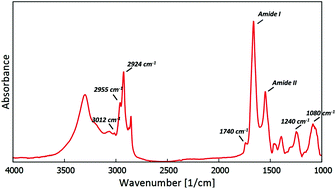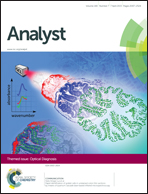The biochemical changes in hippocampal formation occurring in normal and seizure experiencing rats as a result of a ketogenic diet†
Abstract
In this study, ketogenic diet-induced biochemical changes occurring in normal and epileptic hippocampal formations were compared. Four groups of rats were analyzed, namely seizure experiencing animals and normal rats previously fed with ketogenic (KSE and K groups respectively) or standard laboratory diet (NSE and N groups respectively). Synchrotron radiation based Fourier-transform infrared microspectroscopy was used for the analysis of distributions of the main organic components (proteins, lipids, compounds containing phosphate group(s)) and their structural modifications as well as anomalies in creatine accumulation with micrometer spatial resolution. Infrared spectra recorded in the molecular layers of the dentate gyrus (DG) areas of normal rats on a ketogenic diet (K) presented increased intensity of the 1740 cm−1 absorption band. This originates from the stretching vibrations of carbonyl groups and probably reflects increased accumulation of ketone bodies occurring in animals on a high fat diet compared to those fed with a standard laboratory diet (N). The comparison of K and N groups showed, moreover, elevated ratios of absorbance at 1634 and 1658 cm−1 for DG internal layers and increased accumulation of creatine deposits in sector 3 of the Ammon's horn (CA3) hippocampal area of ketogenic diet fed rats. In multiform and internal layers of CA3, seizure experiencing animals on ketogenic diet (KSE) presented a lower ratio of absorbance at 1634 and 1658 cm−1 compared to rats on standard laboratory diet (NSE). Moreover, in some of the examined cellular layers, the increased intensity of the 2924 cm−1 lipid band as well as the massifs of 2800–3000 cm−1 and 1360–1480 cm−1, was found in KSE compared to NSE animals. The intensity of the 1740 cm−1 band was diminished in DG molecular layers of KSE rats. The ketogenic diet did not modify the seizure induced anomalies in the unsaturation level of lipids or the number of creatine deposits.

- This article is part of the themed collections: Alzheimer's Research Month 2016 and Optical Diagnosis (2014)

 Please wait while we load your content...
Please wait while we load your content...